Dual Channel Blood Alcohol Analyser
Introduction
The analysis of blood alcohol components (BAC) in biological matrices is critical to any forensic toxicology laboratory. Ethanol, methanol, ethylene glycol, isopropanol and acetone are volatile organic compounds which must be accurately identified and quantified, especially in legal medical cases in which the compounds are contributing factors to death or criminal investigations.
Additionally, blood alcohol level is important due to its measure as a level of intoxication. Drink-driving laws permit any person to operate motor vehicles and heavy machinery whilst under the influence of alcohol.
Therefore, it is vital that BAC components are quantified accurately.
Experimental
The alcohol volatile organic compound analyser comprised of a SCION 456 GC equipped with a split/splitless injector, a Y split to dual columns and dual FID detectors, as well as the SCION 8400 autosampler. Calibration standards were prepared at a range of 0.01g/dL to 0.4g/dL in blank blood. (Blood had been tested for the presence of BACs; all were negative). Each standard consisted of the volatile organic compounds (ethanol, methanol, ethylene glycol, isopropanol and acetone) with 1-propanol as internal standard.
A blood sample was obtained from a subject that had recently consumed alcohol. 100µL of blood was mixed with 10µL of internal standard. The samples were then diluted to 500µL with Triton X-100 and acetonitrile solution (1.2%:1.8g/dL), centrifuged and 1µL of the supernatant injected into the GC system, onto both columns from the Y split connector. Instrument conditions can be found in Table 1.
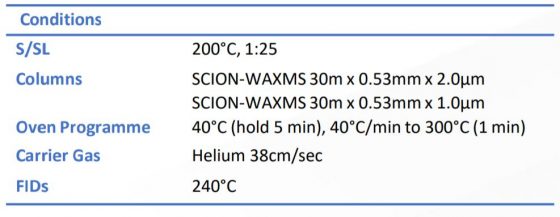
Table 1. Analytical conditions of the GC-FID
Results
Figure 1 shows the chromatogram of a mixture solution containing methanol, ethanol, isopropanol, acetone, ethylene glycol and 1-propanol. Each compound and order of elution were identified based on retention time.
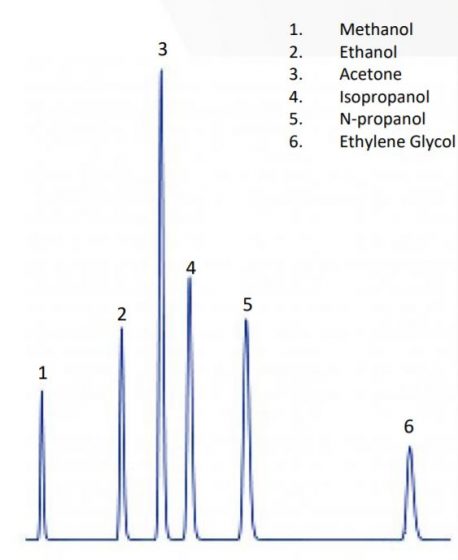
Fig 1. Blood Alcohol Components
Linearity of the system was tested using a calibration range consisting of five concentrations over a range of 0.01g/dL to 0.4g/dL. Each standard was injected three times. Figure 2 shows the excellent linearity of methanol, with an R
2 of 1.
This was reflected through the other blood alcohol components, with the R 2 values being detailed in Table 2.
Table 2 also details the repeatability data for all blood alcohol components at the 0.01g/dL level (n=5), with all components having a %RSD of <1.2%.
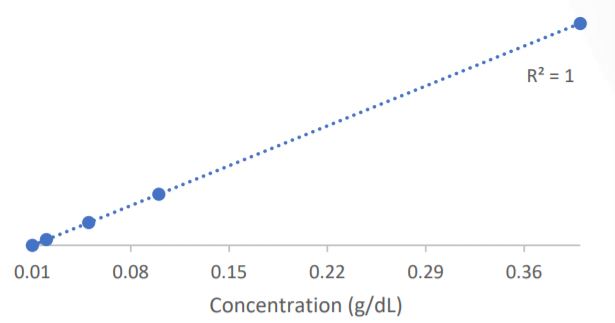
Fig 2. Calibration curve of Methanol

Table 2. Repeatability values of peak area at 0.01g/dL and linearity (n=5)
The limit of quantification (LOQ) was validated at 0.01g/dL and 0.0005g/dL. A blank sample was analysed to measure the background of the system with a 0.01g/dL standard used for the validation of the LOQ, via signal to noise ratio (S/N).
Tables 3a and 3b show the results from the LOQ analysis.

Table 3a. Validation results of LOQ at 0.01g/dL

Table 3b. Validation results of LOQ at 0.0005g/dL
Limit of quantification is excellent on the SCION alcohol analyser with S/N >10 for all BACs at the low level of 0.0005g/dL and S/N >75 at the higher level of 0.01g/dL. These values are well within the quantification limits required for legal cases regarding drink driving even when a zero tolerance policy is implemented.
Figure 3 shows the two chromatograms from the dual channel analyser from a blood sample taken from an individual who had recently consumed alcohol.
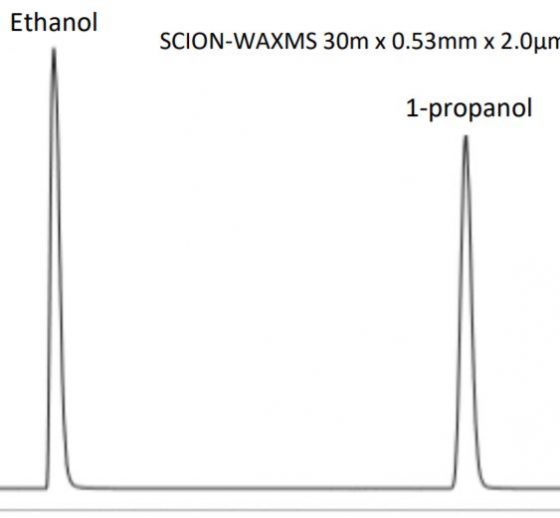
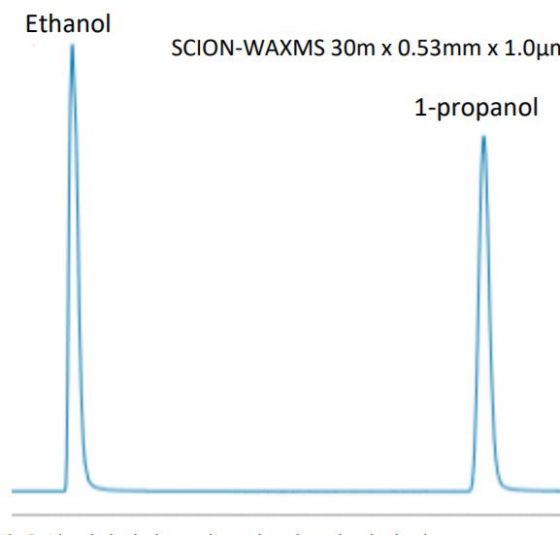
Fig 3. Blood alcohol sample analysed on the dual columns;
Top Trace: SCION-Wax 30m x 0.53mm x 2.0µm
Bottom Trace: SCION-Wax 30m x 0.53mm x 1.0µm
Both chromatograms show excellent resolution and peak shape for ethanol and the internal standard, 1- propanol. Using the calibration curves the sample was confidently quantified.
Conclusion
The SCION alcohol analyser demonstrates excellent sensitivity, repeatability and linearity for the simultaneous identification and quantification of blood alcohol components. The method is highly suitable for routine alcohol analysis in blood samples to provide reliable data with unquestionable confidence of methanol, ethanol, isopropanol, acetone and ethylene glycol in biological samples.
Download Application Note
Download the complete Application Note: Dual Channel Blood Alcohol Analyser
SCION Gas Chromatography Analyser
A SCION Gas Chromatography Analyser was used to conduct this research. Providing excellent solutions for Environmental, Oil and Gas and Chemical industries, find out more about Scion GC Analysers.
If you would like to speak to a member of our team for more information, please don’t hesitate to get in touch. Or to stay in the loop regarding future research and articles from SCION Instruments, why not join us on social media and sign up to our eNewsletter today?
